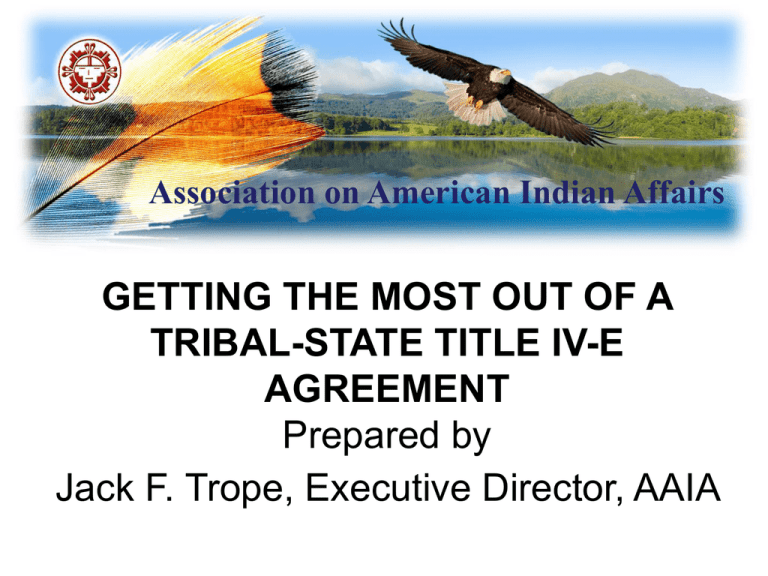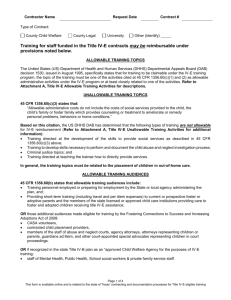Getting the Most out of a Tribal-State Title IV-E Agreement
advertisement

Association on American Indian Affairs GETTING THE MOST OUT OF A TRIBAL-STATE TITLE IV-E AGREEMENT Prepared by Jack F. Trope, Executive Director, AAIA Association on American Indian Affairs Overview of Titles IV-B and IV-E • Basic federal child welfare statutes provide core funding for state child welfare systems • Establish requirements routinely included in child welfare systems -- for example, case plans, case review systems, reasonable efforts requirements, focus on child health and safety and expedited permanent placements. Association on American Indian Affairs Title IV-E: Overview • Provides money for foster care, adoption assistance and relative guardianship payments on an entitlement basis and grant money for services to children aging out of foster care • To be eligible (1) child’s family must have an income below AFDC 1996 eligibility levels, and (2) certain legal findings must have been made by a court of jurisdiction or there must be a voluntary agreement between the party and administering agency. Association on American Indian Affairs Title IV-E: Payments • Reimbursement is received for foster care, adoption assistance and guardianship payments, as well as administration, data systems and training costs connected with providing services to Title IV-E eligible children. •Reimbursement rate for direct payments for children is based on the Federal Medical Assistance Rate (FMAP), a calculation determined by per capita income rates; administration and data systems costs are reimbursed at 50%, most training at 75% Association on American Indian Affairs Title IV-E: Payments • Administration Reimbursement formula: Allowable costs x IV-E Penetration Rate x 50% of federal reimbursement • Examples of reimbursable administrative costs: development of child’s case plan, case management and supervision, case reviews, arranging for services, IV-E data collection, implementation of quality assurance system, overhead related to IV-E activities Association on American Indian Affairs Title IV-E: Payments • Training Reimbursement formula: Allowable costs x IV-E Penetration Rate x 75% of federal reimbursement • Examples of reimbursable training: topics related to administration, social work practice, cultural competency, activities designed to preserve or reunify the family (but not related directly to services), child abuse and neglect issues (not related directly to CPS), effects of separation, child development, visitation, and substance abuse Association on American Indian Affairs Options for Tribes Seeking to Access Title IV-E funding • Option #1 -Tribes may obtain direct funding for Title IV-E by submitting a plan to the Children’s Bureau that meets IV-E requirements; plan must be comprehensive (cover all aspects of Title IV-E) • Option #2 – Access through the state; states have an obligation to negotiate a IV-E agreement with a tribe in good faith if requested by the tribe; agreement can cover all or part of the program Association on American Indian Affairs Options for Tribes Seeking to Access Title IV-E funding (cont.) Tribal-State agreements are an alternative to direct federal funding. Tribes can pursue whichever approach makes sense – direct funding or a tribal-state agreement – depending upon the tribe’s specific situation and needs. Association on American Indian Affairs Advantages of a Tribal-State Agreement • Process may be quicker and easier route to begin operating Title IV-E • Allows tribe to ease its way into the program, including operating only part of the program (although this might be addressed by an agreement even if direct tribal funding) Association on American Indian Affairs Advantages of a Tribal-State Agreement • Process may be quicker and easier route to begin operating Title IV-E • Allows tribe to ease its way into the program, including operating only part of the program (although this might be addressed by an agreement even if direct tribal funding) Association on American Indian Affairs Advantages of a Tribal-State Agreement (cont.) • May be able to utilize some existing state data and other systems • State funding may be available to help with match (although this can also be done when the tribe is funded directly) Association on American Indian Affairs Advantages of a Tribal-State Agreement (cont.) • Can formalize or institutionalize the collaborative arrangement required between states and tribes that may already be occurring (or needs to occur) regarding court proceedings, placements, etc. Association on American Indian Affairs Possible Disadvantages of a Tribal-State Agreement • May have to use some state systems and standards as opposed to ones that are triballydeveloped • In-kind match not available to states as it is to direct-funded tribes • May be subject to more state oversight than tribe would like Association on American Indian Affairs Study of Title IV-E Tribal-State Agreements • AAIA study is funded by Casey Family Programs • Will consist of an analysis and a template-type document identifying best practices in tribal-state agreements • Will be posted on NARF ICWA website and AAIA’s website Association on American Indian Affairs Overview of Title IV-E Agreements • As of the time of our review, there were 98 agreements involving 277 Indian tribal nations in 17 states • Some of the agreements are comprehensive (include maintenance, administration and training) and some are more limited Association on American Indian Affairs Overview of Title IV-E Agreements (cont.) • Many of the agreements are older and were negotiated before states had a legal obligation to negotiate [2008 amendment to the law created that obligation] • While most of the Agreements are “active”, some have not been implemented Association on American Indian Affairs Negotiating a Title IV-E Tribal-State Agreement – Overview • Tribe should decide what it wants in the Agreement before beginning negotiations – does it want to do all of the program or share responsibility with the state • Ideally, all tribal stakeholders (social services, courts, legal department, etc.) should be part of the discussion Association on American Indian Affairs Negotiating a Title IV-E Tribal-State Agreement – Overview (cont.) • Negotiate an individualized agreement • In general (absent explicit tribal decision to the contrary) – include all three elements – administration, training and maintenance payments – particularly if the tribe is doing case management Association on American Indian Affairs Strategies for Engaging States • Identify key state decision makers • Assess tribe’s relationship with state, political and budgetary environment and key interests of the state • Be prepared – understand IV-E, know what other states/tribes have done, and be aware of previous efforts within your own state Association on American Indian Affairs Strategies for Engaging States (cont.) •Identify benefits to state (better outcomes, state budgetary savings, etc.) and have a clear goal of the outcomes desired from a tribal perspective before the discussions or negotiations begin • Make sure you have your full team involved and engaged, including access to experts, federal agency staff and tribal leaders, as needed Association on American Indian Affairs Key Issues – Sovereignty • Explicit recognition of the tribe’s sovereignty and tribal jurisdiction as laid out in the tribe’s governing documents • Base agreement on government-to-government relationship, not merely a vendor relationship • Compliance with federal requirements for program utilizing tribal law wherever possible, not state law Association on American Indian Affairs Key Issues – Sovereignty (cont.) • Recognition of tribal law, including applicability of tribal licensing requirements and customary adoption (adoption without termination of parental rights) • No requirement that sovereign immunity be waived; development of alternative dispute resolution mechanisms • May want to address ICWA compliance in agreement. Association on American Indian Affairs Key Issue – Building Tribal Capacity Training – can include not only reimbursement for tribally-run trainings and for attendance at third party trainings, but also notice and access to relevant State trainings Access to State technical assistance – many of the Title IV-E requirements, especially those relating to data collection and processing of administrative costs are highly technical; state T/A should be provided, be collaborative in nature, and targeted to compliance with statute, not micro-managing of tribal program Association on American Indian Affairs Key Issue – Building Tribal Capacity (cont.) • Access to State databases, including access to the State background check system and child abuse registries •Developing relationship with the state and a written agreement to protect children can build tribal capacity by clarifying roles and responsibilities of state and tribe. • Maximizing resources to the tribe and its families (see below) Association on American Indian Affairs Key Issue – Maximizing Resources for Tribal Programs and Families • Include payments for foster care maintenance, guardianships and adoption assistance • Maintenance payments should include not only the base payment, but also payments for “special circumstances” such as difficulty of care, medically fragile and therapeutic foster care rates Association on American Indian Affairs Key Issue – Maximizing Resources for Tribal Programs and Families (cont.) • Many states pay all or part of the match; where the state does not, make sure tribal FMAP applies • If the state has a IV-E waiver, agreement should allow participation in the waiver program if possible Association on American Indian Affairs Other – Chafee Program • Tribes can also access the John H. Chafee Independent Living Program through a Tribal-State agreement and states are required to negotiate such agreements in good faith •Chafee provides assistance to older youth transitioning out of foster care (education, employment, living skills) Association on American Indian Affairs Provisions to Avoid • State taking back a percentage of the federal reimbursement to cover its overhead • Application of state laws, policies and procedures that exceed federal requirements. Association on American Indian Affairs Continued State Role – Direct Funding In case of direct funding to tribes, there may still be a role for a tribal-state agreement: •Coordinating with tribes, especially in regard to tribal service areas beyond reservation boundaries and cases involving transfer from state court to tribal court •Ensuring that no child loses funding as a result of the tribe receiving direct funding Association on American Indian Affairs Direct Funding Agreement (cont.) • Providing funding to tribe to help meet the match requirement • Cross-system coordination between tribal and state IV-E agencies, TANF and child support agencies and with the state Medicaid office • Tribe can sub-contract with state to operate parts of the program Association on American Indian Affairs Direct Funding Agreement (cont.) • Providing training, access to state data systems, transportation and other state services and products • Tribe may be able to claim some of the services and products provided as in-kind expenses • Facilitate involvement of tribes in state court improvement planning (and assist tribes who have received court improvement dollars for their tribal courts, if requested) Association on American Indian Affairs Direct Funding Agreement (cont.) • Providing for tribal engagement in the development of state IV-E and IV-B plans and Child and Family Services reviews, particularly in terms of ICWA compliance • Building collaborations and partnerships for a variety of purposes;, for example, reducing numbers of children in foster care and disproportionality, providing culturally sensitive services and training, recruiting more Native foster homes Association on American Indian Affairs Conclusion For many tribes, tribal-state agreements may be a mechanism to gain access to the Title IV-E program. If properly prepared before beginning negotiations, a tribe should be able to reach an agreement that will respect tribal sovereignty, enhance tribal capacity, and maximize resources for the tribe and tribal families. Even where direct funding is sought, a tribal-state agreement may sometimes be helpful to a tribe.









